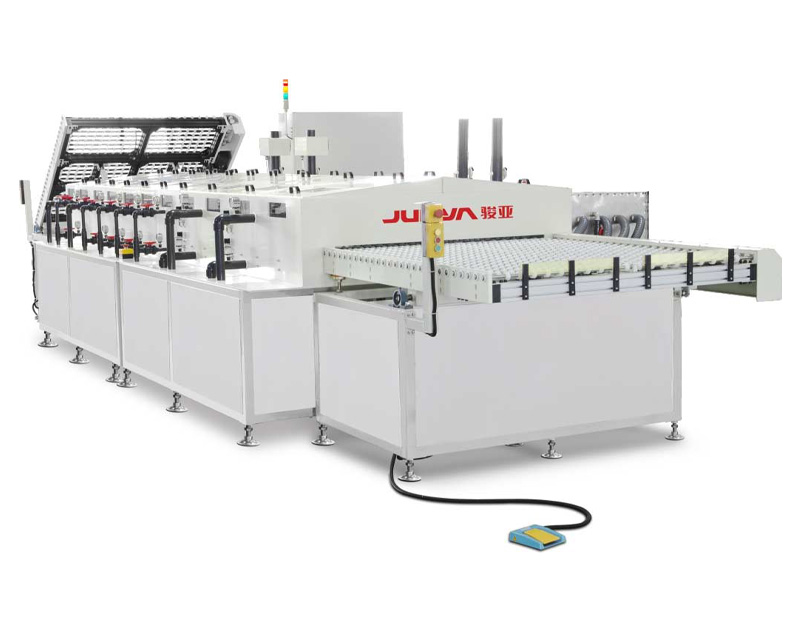How to ensure glass cleanliness and quality during insulating glass cleaning?
Ensuring cleanliness and quality during the cleaning of insulating glass is critical. Here are some key steps and considerations that can help achieve this:

1. Use machine cleaning method
As manual cleaning cannot guarantee the quality of cleaning, machine cleaning method must be used to ensure the cleanliness of the glass. Machine cleaning not only improves cleaning efficiency, but also avoids uneven cleaning caused by human factors.
2. Check the glass without scratches
Before cleaning, the glass needs to be carefully inspected for scratches to ensure that the cleaning process does not cause further damage to the already damaged glass. This step is especially important because any minor scratches may affect the appearance and performance of the final product.
3. Water Treatment Equipment
In order to improve the adhesion and cleanliness of the sealant to the glass, it should be cleaned using water treatment equipment. This equipment removes impurities and minerals from the water, thus ensuring the purity of the cleaning water.
4. Filtering recycled water
In order to save water and ensure long-term use, the water should be filtered to achieve water recycling. This not only helps the environment, but also reduces operating costs.
5. Drying air treatment
The drying air of the insulating glass washing machine should be filtered to ensure that the cleaned glass surface is free of water droplets, water stains and other stains. The temperature and air volume of the drying air also need to be precisely controlled to avoid thermal stress or excessive cooling of the glass.
6. Light Inspection
The cleaned glass needs to pass a light test to check whether the glass surface is completely clean and free of residual stains. This step is usually carried out under specific lighting conditions in order to detect any small defects more clearly.
7. Adjustment of machine parameters
If beads of water, water stains or other stains are detected, the machine running speed, heating temperature, air flow, brush gap, etc. should be adjusted until the desired cleaning effect is achieved. This requires a lot of experience and expertise on the part of the operator in order to make adjustments quickly and accurately.
8.Quick assembly
The washed glass should be assembled into insulating glass within 1 hour to avoid re-contamination or damage. Rapid assembly not only improves productivity, but also reduces the time the glass is exposed to the air, thus reducing the risk of contamination.
9. Wear gloves
During the assembly process, operators need to wear clean, oil-free gloves to avoid secondary contamination of the glass. The choice of gloves is also very important, should be made of materials that do not lose hair and do not produce static electricity.
10.Semi-finished products storage
If there are conditions, it is best to use the semi-finished glass storage trolley, the glass piece to piece separation, in order to prevent friction scratches. The design of the storage trolley should take into account the size and weight of the glass to ensure safe and secure storage of each piece.
In summary, by following these steps and precautions, the cleanliness and quality of insulating glass in the cleaning process can be effectively ensured.
In practice, the following points should also be noted:
1. Select the appropriate cleaning agent
According to the glass material and the type of pollutant, choose the appropriate cleaning agent to ensure that it can effectively remove stains without causing damage to the glass surface. Different types of contaminants may require different cleaning agent formulations, so careful evaluation and testing is required.
2. Regular maintenance of cleaning equipment
Regular inspection and maintenance of cleaning equipment ensures its proper functioning and avoids incomplete cleaning or glass damage due to equipment failure. A maintenance programme for the equipment should include routine inspection, regular maintenance and emergency repairs.
3. Training of operators
Professional training for operators to enable them to master the cleaning process and equipment operation, improve cleaning efficiency and quality. The training content should cover both theoretical knowledge and practical skills to ensure that operators can independently cope with a variety of situations.
4. Record cleaning data
Record the time of each cleaning, the type of cleaning agent used, the effect of cleaning and other information, in order to analyse and improve the cleaning process. These data can not only be used to track problems and improve the process, but also as an important basis for quality control.
In short, through strict process control, equipment maintenance and personnel training, it is possible to ensure that insulating glass achieves optimum cleanliness and quality during the cleaning process. This not only helps to improve the overall performance of the product, but also extends its service life and provides customers with better quality products and services.
